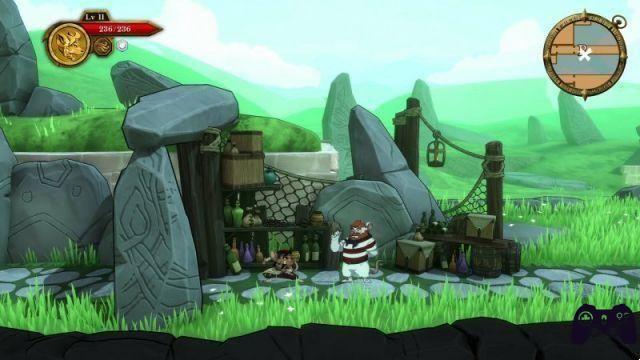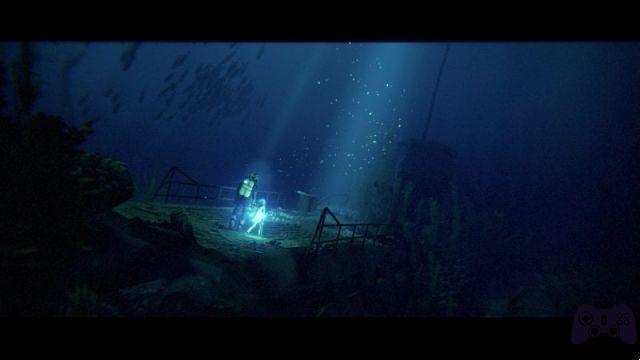Honjo, the setting of this game, is the southern area of the modern city of Sumida, a district of Tokyo, and is today a densely populated area of the enormous Japanese megalopolis, between well-kept residential neighborhoods and state-of-the-art infrastructure. , but it hasn't always been like this. In ancient times, this area was essentially a swamp, until systematic construction began in the middle of the Edo period, starting with the great Ryogoku Bridge that connected the central part of Edo with the still wild area. The recovery involved the construction of numerous canals, which were progressively filled in to make way for more buildings and roads, until the original appearance of a swamp rich in water and vegetation was completely lost.
However, something has remained: that idea of a region located on the border between the city and the mysteries of the forest, the dark, stagnant and unhealthy waters that house mysterious and dark creatures, have stimulated stories of spirits and curses. throughout the centuries, remaining imprinted in the common imagination and evolving into urban legends that endure to this day. These are precisely the bases of the strange adventure built by Square Enix that we examine in review of Paranormasight: The Seven Mysteries of Honjo. The Seven Mysteries of Honjo (which often number ten or even more, according to versions told by word of mouth) are a collection of the most widespread legends that circulate in the area in question, each of them related to a curse. specific and intertwined with each other. constitute another fascinating mystery: the Ritual of the Resurrection.
Il interactive story It develops in a choral manner, following different points of view of various characters, all involved in some way with the Seven Mysteries and in the search for the Ritual, victims or executioners of a ruthless fight between the bearers of the curses. “How far would you go to bring someone back to life?” It is a kind of motto that Paranormasight presents, and although it may seem like a not very original premise, it finds unexpected novelties in a game that is capable of surprising and involving even beyond what was expected.
cursed tales

Paranormasight: The Seven Mysteries of Honjo are, for all intents and purposes, one visual novel, with some adventure elements that refer to the interaction with the objects of the setting and the characters, as well as the decisions that must be made to influence the course of the story. This takes place during a night darker than others, around the 80s of the last century: several disparate characters find themselves in possession of curses linked to the mysteries of Honjo and involved in the search for the Ritual of the Resurrection. They are very different people, each one moved by the desire to find someone lost forever but who, under certain conditions, could return: there is a mother who cannot resign herself to the death of her son, a student who wants to see clearly in the apparent suicide of a friend, a normal employee who falls in love with a girl dedicated to the occult and finds himself involved in a disturbing situation, a detective specialized in paranormal cases who investigates the murder of a colleague. All of them are faced with the possibility of resurrecting someone from the dead, but to do so they are forced to kill to gain power by collecting "soul scum", in a total clash between bearers of curses.
The events follow several connected narrative arcs, arranged throughout a real-life setting. "historical map" with crossroads and turns, which allows you to retry individual episodes and experiment with different solutions to find new outlets for the story. We can go from one protagonist to another, in some cases in a forced way because the advancement of one narrative line also implies the unlocking of the others, or try different options and see the consequences also in parallel and intersecting stories.

What surprises in Paranormasight is the quality of the history: Setting a game around urban legends may seem like a banal choice, but the authors have managed to build interesting scenarios for each individual character, which manage to involve us in reading without ever losing pace. Admittedly, the horror tone is tempered by the overall look and structure of the game itself, but some of the themes covered and some of the decisions we make can still be quite memorable. In this sense, it should be noted that the game does not have spoken dialogues and The texts are exclusively in English or Japanese, which could represent an obstacle to its use.
Interactive storytelling

He "game" focuses on 360-degree exploration of static screens, moving a cursor that allows you to interact with the objects and characters present in the various settings that form the backdrop of the individual episodes of the stories. It is a basic interaction that On the other hand, to be honest, it doesn't become a lot of puzzles: essentially it's about finding the object or character that moves the story forward, mainly through the dialogues, which are the real supporting element of the entire structure of the game. As a kind of inventory and the characters can carry some objects, the possibility of acting on the scenarios is limited, resulting only in descriptions and thoughts of the protagonist about what surrounds him, leaving the moments of "action " to direct the exchanges with the other characters. It refers above all to the choice of topics to discuss, the answers to give and in general the attitude to adopt with others, which can determine important consequences in the development of the story .
Given that direct confrontation between the "bearers of the curse" is a central element of Paranormasight, the most intense moments are undoubtedly those that have to do with the choice of whether or not to use curses, because these can lead to the death of the characters and therefore to situations of capital importance in the development of the plot.

When the protagonists take possession of the different stones of power, they obtain a specific ability linked to each of the seven mysteries of Honjo, which allows them to kill the interlocutor once certain conditions are met (ensuring that he turns his back on us). , that he lies to us, that you listen to music for a certain time and other special requests). The most interesting mechanic of the game is, therefore, putting the interlocutor in the ideal situation to be able to suffer our curse, at the same time we try to understand what the opponent's power is and avoid falling into his trap.
These situations also involve some of the best puzzle present in the game, which unfortunately are also quite rare. In just a few seconds we find ourselves deciding how to act and, in some cases, the solution to the enigma that saves us from certain death is not easy to glimpse at first: certain moments are truly surprising, since they force us to think outside the box. the box of a normal adventure. It is a shame that these phases are so infrequent and tend to concentrate on a first part of the game that has much more pace, although perhaps less interesting on a narrative level than the following ones.
a particular atmosphere

Given its purely narrative nature, Paranormasight: The Seven Mysteries of Honjo is very reminiscent of the manga tradition, presenting itself as a kind of interactive Japanese graphic novel. There graphics, in 2D, mixes realistic representations of the settings, which are based on real settings in the Sumida area, with characters drawn in a more stylized way, but characterized in a notable way. Everything contributes to creating a particular atmosphere that permeates the game, capable of strongly characterizing this experience, even beyond the numerous Japanese horror films available on the market. Beyond the quality of the writing and the construction of the different characters, what emerges in Paranormasight is its ability to merge the metaphysical with the everyday and ancient mythology with the modern, in a syncretism typical of Japanese culture and that found Here is an excellent expression. . It's no surprise that the creative director is Gen Kobayashi, who has already explored similar themes in The World Ends with You.
The choice to place the events in the 80s contributes to constructing this situation, reflecting a typical element of Showa period in Japan: Also playing with the tendency towards occultism that emerged in this period, the contrast between an era entirely projected into the future and certain folkloric traditions that continue to survive, latent but deeply rooted, becomes even more evident. Tokyo thus turns out to be built on foundations that recall dark local traditions, which can emerge disturbingly on a quiet metropolitan night, fueled by the obsessions of ordinary people. All of this is not a mere digression but is an integral part of the Paranormasight experience, which has almost documentary elements: the game often pushes us to consult a kind of compendium that collects information about settings and characters, absorbing us in an enormous amount of detail. . ranging from the classic legends of feudal Japan to historical and cultural descriptions of the places we explore, which merge perfectly with the reconstructions of the biographies of the characters and the news events of which they are protagonists.
Conclusions
Tested version Nintendo Switch digital delivery Steam, Nintendo e-store, app store, Google Play Price 19,99 € Holygamerz.com 8.5 Readers (7) 7.7 your voteThere is something truly special about Paranormasight: The Seven Mysteries of Honjo. Although it is presented as a horror visual novel like many have been seen, it is capable of immediately establishing a very particular atmosphere given by the fusion between ancient legends and a modern setting, in a syncretism that fits squarely in the Japan of the period. Showa. which serves as a backdrop to the events. The narrative is based on good writing and advances at a remarkable pace, keeping us glued from beginning to end also thanks to the excellent construction of the characters, which plays with some stereotypes but also manages to break molds. The phases of direct confrontation between the bearers of the curse manage to bring out a truly rare tension for a game based essentially on the written text, staging memorable moments. It's a shame that there are few real puzzles and that they are especially concentrated on the initial phase, leaving room mostly for the excellent branching narrative.
PRO
- The stories are very interesting and attractive.
- Battles against curse bearers feature some memorable moments
- Well thought out and packaged setup.
AGAINST
- The actual puzzles are few and poorly distributed.
- The cursor interface is not ideal on consoles.






